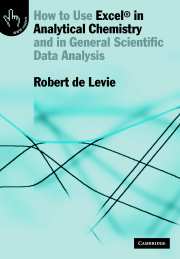3 - More on least squares
Published online by Cambridge University Press: 05 June 2012
Summary
In this chapter we will describe some of the more sophisticated uses of least squares, especially those for fitting experimental data to specific mathematical functions. First we will describe fitting data to a function of two or more independent parameters, or to a higher-order polynomial such as a quadratic. In section 3.3 we will see how to simplify least-squares analysis when the data are equidistant in the dependent variable (e.g., with data taken at fixed time intervals, or at equal wavelength increments), and how to exploit this for smoothing or differentiation of noisy data sets. In sections 3.4 and 3.5 we will use simple transformations to extend the reach of least-squares analysis to many functions other than polynomials. Finally, in section 3.6, we will encounter so-called non-linear least-squares methods, which can fit data to any computable function.
Multi-parameter fitting
We can expand least-squares fitting to encompass more than one dependent variable. Here we will fit data to an equation of the form y = a0 + a1 x1 + a2 x2. Please note that the method to be used is not restricted to merely two dependent variables, but can in principle be applied to any number of xi-values. In practice, the Regression routine of Excel can handle up to 16 different dependent variables.
- Type
- Chapter
- Information
- How to Use Excel® in Analytical ChemistryAnd in General Scientific Data Analysis, pp. 90 - 120Publisher: Cambridge University PressPrint publication year: 2001

